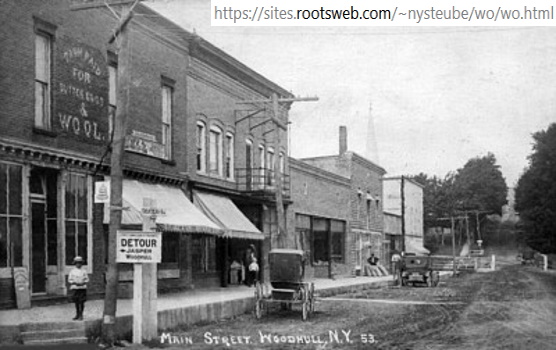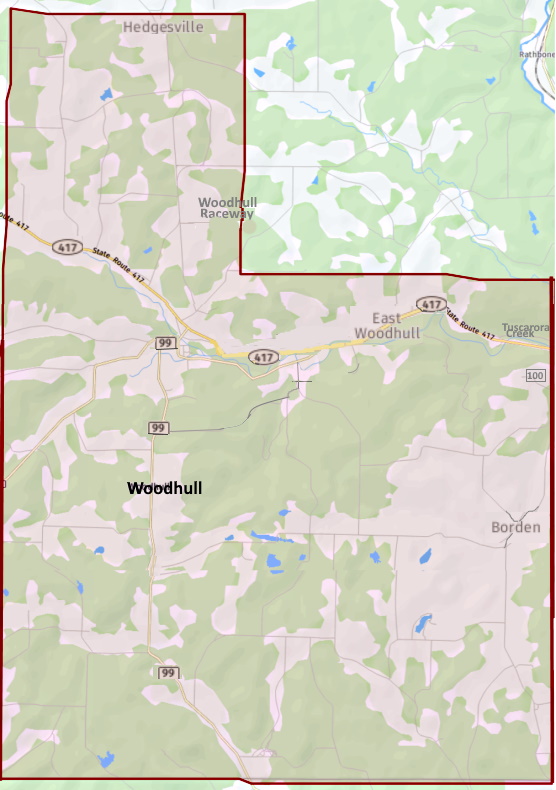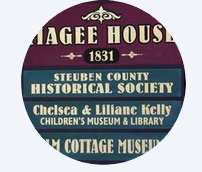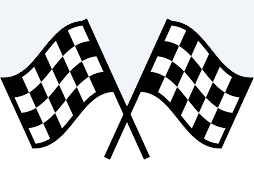Woodhull Area Community and Schools: {not inclusive list}

The first settlers arrived around 1804. Among the first settlers were Caleb Smith who built the town's first three houses. The town was formed from the Towns of Troupsburg and Addison in 1828. In 1856, part of Woodhull was taken for the Town of Rathbone.
Few landmarks remain at Woodhull to mark the activities of this pioneer family. When they came to Woodhull the area covered by the residential section of the village was a grove of great maple and hemlock trees. The old town hall, which once was the first village school, stands on the very site where "the Smith boys," hung their iron kettle to make maple sugar for the family needs. Nearly a century and a half has passed since the smoke curled skyward around that kettle, and the scenes of 1806 have vanished almost as completely as that evaporated smoke.
Gone are the stately pines and hemlocks, gone are the log cabins and the men and women who lived their lives in them. Left today are only the everlasting hills which rolled up to the north and south the day Caleb Smith brought his family into the valley which was to be called Woodhull. The surface is hilly upland; the soil a clayey and gravelly loam. The principal stream is Tuscarora creek, which flows north of the centre of the town in an easterly direction."
It is hard for any person to realize that 110 years ago there was not a white person in all the territory now known as the town of Woodhull. It is also hard to realize that 93 years ago there was not a rod of public highway in the entire town. There is no finer section of farm lands in this county than the southeast section of this town, in which is situated the hamlet of Borden. It is a section of splendid farms, beautiful homes and almost palatial residences. And yet you can hardly realize that a little more than 80 years ago Andrew COLGROVE killed in this very section a female panther and 9 of her cubs, and that he received bounties from Steuben county which amounted to $137.50 as recorded at the Steuben County Clerk's Office for killing them. Nor do those of the present generation realize that the early settlers had no trouble even 60 or 70 years ago in supplying their tables with brook trout from the small streams of that section and venison and bear meat from the forests then growing upon the rich farming lands they now occupy. Yet it is an actual fact that they did.
One great drawback in the wilderness was the lack of roads. There was not a rod of public highway in the town much earlier than 1825. Up to the year 1850 the roads over the entire town were in a wretchedly poor condition. But as the settlement continued to grow and the town became more populous good roads have been the rule so that we know but little of the road troubles encountered by the early settlers. One of the four great lines of stone road now being constructed across the state from east to west passes through the town and will be of great benefit to the farming community and all others. One hundred teams and three or four hundred men are this season working in the town on its construction, having all kinds of costly machines etc. for it's construction.
The first man who preached a sermon in the town was the Rev. John KENT, a Baptist preacher.
Churches---there are two churches in the village of Woodhull, the Baptist, which was the first organized church in the town, it was organized in the year 1837. The Rev. James CLARK preached the opening sermon, the Rev J. B. CHASE acted as clerk. The church then had 17 members. Stephen KENT was elected clerk; he was a son of Rev. John KENT and a brother of Henry F. KENT.
The Methodist church was organized in 1846, the land and most of the money to build the church building was donated by Alfred SMITH. The first Methodist preacher was Rev. KING, who came once a month on horseback and preached to the settlers for some years prior to the building of the church.
Schools---The first school house in Woodhull was built in 1808 by Abram Thomas, the second at Brady's Corners in 1823, and the third near Hedgesville in 1830. The Woodhull Academy was built in 1866 and 7. There was for many years a large attendance at that school. Many scholars came here from abroad, until it was finally turned into a union school.
Communities and locations in the Town of Woodhull
- Borden – A hamlet near the east town line on County Road 101.
- East Woodhull – A hamlet east of Woodhull hamlet on NY-417 at County Road 81.
- Hedgesville – A hamlet in the north part of the town on County Road 102. It is one of the oldest communities in the town.
- Tuscarora Creek – A stream flowing eastward from the town past Woodhull and East Woodhull.
- Woodhull – The hamlet of Woodhull is south of NY-417 in the north part of the town. The village was at the junction of County Roads 82, 99, and 129 and is on Tuscarora Creek. Woodhull became an incorporated village in 1899, abandoned its village status in 1987.
- Woodhull Raceway – The Woodhull Raceway was opened in 1964 by George Williams who with his two sons, Jim and Bob designed and constructed the track.
Wikipedia.org [Woodhull]
GenealogyTrails.com [Woodhull]
RootsWeb.com [Woodhull]


Facebook: Steuben Historical Society [Woodhull] [has photos and information]

Woodhull Raceway was opened in 1965 by George Williams who with his two sons, Jim and Bob designed and constructed the track.
WoodhullRaceway.com [History and Current Information]